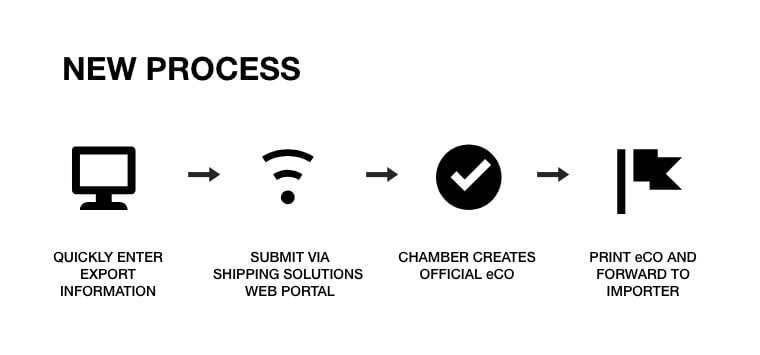The International Trade Blog Export Forms
The Chamber of Commerce and Export Documents: The Certificate of Origin
On: August 12, 2024 | By:  David Noah |
10 min. read
David Noah |
10 min. read
 Chambers of commerce play an important role in international trade—especially when it comes to verifying where products are made. For exporters, that role often comes into play when obtaining a certificate of origin, a document used by customs authorities around the world to verify the country in which goods were manufactured.
Chambers of commerce play an important role in international trade—especially when it comes to verifying where products are made. For exporters, that role often comes into play when obtaining a certificate of origin, a document used by customs authorities around the world to verify the country in which goods were manufactured.
This article explains how chambers of commerce help exporters create and certify non-preferential certificates of origin, how the process has evolved from paper to electronic certification, and what exporters should know about legalization, accuracy and best practices.
What Is a Certificate of Origin
A certificate of origin (COO) is an export document that certifies the country where a product was manufactured. It may be required by the importing country’s customs authorities, banks or importers for several reasons, including:
- Determining duty rates and eligibility for trade measures
- Meeting import licensing and customs clearance requirements
- Satisfying buyer or letter of credit terms
A non-preferential certificate of origin—also known as a generic certificate of origin—is the most common type. It simply states the country of manufacture and does not claim any tariff benefits under a free trade agreement (FTA). Preferential proofs of origin, such as a USMCA Certificate or a statement of origin, are separate documents and are not typically certified by chambers of commerce.
How Chambers of Commerce Support Exporters
There are more than 7,000 chambers of commerce across the United States, serving local, regional and industry-specific business communities. Among their many activities, chambers are authorized to authenticate export documents, including certificates of origin, on behalf of exporters.
By stamping or digitally certifying a certificate of origin, a chamber of commerce serves as an impartial third party attesting that the information provided by the exporter appears to be correct based on supporting documentation. The chamber does not guarantee the accuracy of the data—it verifies that the exporter has supplied appropriate evidence.
Key Responsibilities of a Chamber
- Review manufacturer declarations, invoices or other documents that show where goods were produced.
- Confirm that the exporter has signed and completed the certificate correctly.
- Stamp or digitally certify the certificate using a secure, controlled seal.
- Maintain certification records as required under international best practices.
ICC Guidelines and Accreditation
The International Chamber of Commerce (ICC), through its World Chambers Federation (WCF), established global best practices for issuing certificates of origin. The ICC’s International Certificate of Origin Guidelines define standardized procedures for chambers, including secure seal management, record retention and staff training.
Chambers that meet these standards may apply for recognition under the ICC World Chambers Federation Accreditation Chain—a global network of trusted chambers whose eCOs can be verified through the ICC Verification Portal. Using an ICC-accredited chamber helps ensure that your certificate will be recognized internationally and accepted by customs authorities without delays.
The American World Trade Chamber of Commerce (AWTCC) is one of the few U.S. chambers accredited through this system. Shipping Solutions partners with AWTCC to provide exporters with ICC-compliant electronic certificates of origin.
The Traditional (Paper) Process
 Before the rise of electronic certification, exporters typically followed these steps to obtain a paper certificate of origin:
Before the rise of electronic certification, exporters typically followed these steps to obtain a paper certificate of origin:
- Complete a chamber liability form or membership application.
- Provide supporting evidence—such as a manufacturer’s declaration or commercial invoice—showing where the goods were made.
- Fill out the certificate of origin form (you can download a free COO template here).
- Bring the documents to your local chamber of commerce for review and stamping.
- Pay a certification fee (usually discounted for chamber members).
- Forward the stamped certificate to your buyer, broker or freight forwarder.
While straightforward, this paper-based process could be slow and costly, especially when courier delivery or multiple copies were required.
The Modern (Electronic) Process
Today, exporters can save time and cost by using electronic certificates of origin (eCOs). Through a secure online portal, exporters upload the required documents, submit their data, and receive a digitally signed certificate from an accredited chamber—often within hours.

With an eCO, you can:
- Submit documentation online 24/7.
- Receive an ICC-recognized certificate in digital or printed form.
- Reduce courier costs and administrative delays.
- Ensure authentication through the ICC’s secure verification database.
Shipping Solutions’ electronic certificate of origin service costs $50 per certificate ($25 for Annual Maintenance Program subscribers). The process is quick, secure and recognized by customs authorities worldwide.
Companies that use Shipping Solutions export documentation and compliance software can submit their eCO applications right from the software without having to reenter the export information that they are using to create all their other export forms. Learn more about using Shipping Solutions software for all your documents including certificates of origin. Click here to schedule a free, no-obligation demo, or watch this video to see how it works:
Legalization and Consularization
In some cases, the destination country may require additional authentication of export documents—known as legalization or consularization. This process involves verifying the chamber-certified certificate through the country’s U.S. embassy or consulate before export.
Shipments to certain Middle Eastern, African and Latin American countries, for example, may require consular legalization. Your chamber or freight forwarder can advise when this applies and assist in coordinating the consular process.
Electronic certificates of origin issued by ICC-accredited chambers such as the AWTCC are increasingly accepted in place of paper legalization, but exporters should always verify requirements with the importer or destination customs authority.
Best Practices for Working with a Chamber of Commerce
- Provide accurate and complete information. “Country of origin” refers to where the goods were manufactured, not from where they are shipped.
- Use consistent documentation. The manufacturer’s declaration and invoice should match the COO details.
- Avoid self-stamping. Only authorized chamber personnel may apply the official seal or digital certification.
- Confirm ICC compliance. Ask if your chamber follows the ICC/WCF International Certificate of Origin Guidelines or is part of the ICC Accreditation Chain.
- Maintain copies. Keep COO records for at least five years (or longer if required by regulation).
When a Chamber May Decline to Stamp a COO
A chamber of commerce may refuse to stamp a certificate if:
- The exporter fails to provide satisfactory proof of origin.
- Information on the certificate conflicts with the supporting documents.
- The exporter attempts to certify a preferential COO that does not require chamber involvement.
- The chamber cannot verify the exporter’s identity or authorization.
If this occurs, review your documentation, clarify the country of manufacture, and resubmit through an accredited chamber.
Example: How It Works in Practice
Scenario
A Minnesota-based exporter ships industrial valves to a customer in the United Arab Emirates. The importer requests a non-preferential certificate of origin for customs clearance.
Process
- The exporter prepares the invoice and manufacturer’s declaration stating the valves were made in the U.S.
- Using the Shipping Solutions eCO portal, they upload these documents and complete the certificate form.
- The AWTCC reviews and digitally certifies the certificate under ICC guidelines.
- The exporter downloads the stamped certificate, prints it if needed, and forwards it to the importer.
Result
The importer verifies authenticity through the ICC portal and clears the shipment without delay.
FAQ: Certificates of Origin
-
Do I need a certificate of origin for every export shipment?
Not always. Some countries and buyers don’t require it, but many importers request one to meet customs or banking requirements. See When to Use a Certificate of Origin Form for Your Export Shipments for more details. -
What’s the difference between a generic certificate of origin and a preferential certificate?
A generic (non-preferential) COO states where goods were made and is usually certified by a chamber of commerce. A preferential COO claims tariff benefits under a free trade agreement and typically uses a separate form that does not require chamber certification. -
Are electronic certificates accepted everywhere?
Most customs authorities now recognize eCOs issued by ICC-accredited chambers. Always confirm acceptance with the importer or local broker before shipping. -
How long does certification take?
Electronic certificates of origin can often be processed within hours, while paper versions may take several days depending on courier time and chamber workload.
Final Thoughts
Chambers of commerce continue to play a vital role in verifying the origin of exported goods. By moving to electronic certification and following ICC best practices, exporters can save time, reduce errors and improve the credibility of their export documentation.
Ready to simplify your certificates of origin?
Click here to learn more about the eCO process and to register for a free account.
Like what you read? Subscribe today to the Passages: The International Trade Blog to get the latest news and tips for exporters and importers delivered to your inbox.
This article was first published in January 2016 and has been updated to include current information, links and formatting.

About the Author: David Noah
As president of Shipping Solutions, I've helped thousands of exporters more efficiently create accurate export documents and stay compliant with import-export regulations. Our Shipping Solutions software eliminates redundant data entry, which allows you to create your export paperwork up to five-times faster than using templates and reduces the chances of making the types of errors that could slow down your shipments and make it more difficult to get paid. I frequently write and speak on export documentation, regulations and compliance issues.


